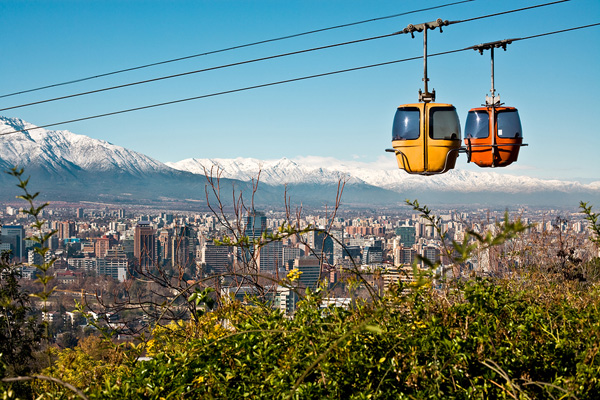
| Apartment Rentals | Rent for a one-bedroom apartment in the city center of Santiago is around $800 USD per month. Rent for a three-bedroom apartment in the city center is around $1,500 USD per month. Rent for a one-bedroom apartment outside of the city center is around $500 USD per month. Rent for a three-bedroom apartment outside of the city center is around $1,000 USD per month. |
| Apartment Purchases | The cost of purchasing an apartment in Santiago varies greatly depending on the size, location, and condition of the property. Generally, the cost of a one-bedroom apartment in the city center is around $150,000 USD. The cost of a three-bedroom apartment in the city center is around $250,000 USD. The cost of a one-bedroom apartment outside of the city center is around $100,000 USD. The cost of a three-bedroom apartment outside of the city center is around $150,000 USD. |
| Transportation | Public transportation in Santiago is relatively inexpensive. A single bus ride costs around $1 USD. A monthly bus pass costs around $30 USD. Taxis are also available and the cost of a ride depends on the distance traveled. Generally, a taxi ride within the city center costs around $5 USD. |
| Groceries | The cost of groceries in Santiago is relatively low. A loaf of bread costs around $1 USD. A liter of milk costs around $1 USD. A dozen eggs costs around $2 USD. A kilogram of apples costs around $2 USD. A kilogram of potatoes costs around $1 USD. |
| Restaurants | The cost of eating out in Santiago varies greatly depending on the type of restaurant. A meal at a fast food restaurant costs around $5 USD. A meal at a mid-range restaurant costs around $15 USD. A meal at a high-end restaurant costs around $30 USD. |
| Utilities | The cost of utilities in Santiago is relatively low. The average cost of electricity for a two-bedroom apartment is around $50 USD per month. The average cost of water for a two-bedroom apartment is around $20 USD per month. The average cost of internet for a two-bedroom apartment is around $30 USD per month. |
| Private School Tuition | The cost of private school tuition in Santiago varies greatly depending on the school. Generally, the cost of preschool tuition is around $500 USD per month. The cost of elementary school tuition is around $1,000 USD per month. The cost of middle school tuition is around $1,500 USD per month. The cost of high school tuition is around $2,000 USD per month. |
Monthly Budget for Retirees in Santiago
“The cost of living in Santiago is generally considered to be quite reasonable. Prices for basic necessities such as food, transportation, and housing are generally lower than in other major cities in the region. However, the cost of living can vary depending on the area of the city and the lifestyle of the individual. For example, living in the city center can be more expensive than living in the suburbs. Additionally, the cost of entertainment and leisure activities can be higher than in other cities,” said one expat living in Santiago.
Can I live in Santiago on $1,500 a month?
“I’ve been living in Santiago for a while now, and I can tell you that it’s possible to live comfortably on $1,500 a month, but you’ll have to make some sacrifices. First, you’ll need to find an affordable neighborhood to live in. Some of the more affordable neighborhoods in Santiago are Ñuñoa, Providencia, and San Miguel. These areas have a good mix of residential and commercial spaces, and you can find decent apartments for around $500 to $700 a month. On the other hand, you should avoid more expensive neighborhoods like Las Condes, Vitacura, and Lo Barnechea, as rents can be much higher there.When it comes to transportation, you can save money by using public transportation like buses and the metro, which are quite affordable and efficient. A monthly public transportation pass costs around $45. If you prefer to drive, keep in mind that gas prices and parking fees can add up quickly.For groceries and eating out, you’ll need to be mindful of your spending. Local markets and supermarkets offer affordable options for groceries, and you can expect to spend around $300 to $400 a month on food. Eating out can be more expensive, especially in touristy areas, so try to limit dining out to once or twice a week and opt for more affordable local restaurants.Entertainment and leisure activities can also be a significant expense, so you’ll need to prioritize and choose wisely. There are plenty of free or low-cost activities in Santiago, like visiting parks, museums, and cultural events. However, if you want to go out for drinks, see a movie, or attend a concert, you’ll need to budget accordingly.In terms of healthcare, you can choose between public and private healthcare systems. Public healthcare is more affordable, but the quality of care and waiting times can be an issue. Private healthcare offers better quality and faster service, but it can be more expensive. If you have a pre-existing condition or require regular medical care, you may want to consider purchasing private health insurance.Overall, living comfortably on $1,500 a month in Santiago is possible, but you’ll need to be mindful of your spending and make some sacrifices. By choosing an affordable neighborhood, using public transportation, and being selective with your entertainment and leisure activities, you can make it work,” commented an expat living in Santiago.
Can I live in Santiago on $3,500 a month?
“I’ve been living in Santiago for a while now, and I can tell you that it’s definitely possible to live comfortably on $3,000 a month, even if you’re used to modern amenities. However, you might have to make some sacrifices in terms of the neighborhood you choose to live in and the size of your apartment.For example, some of the more expensive neighborhoods like Las Condes, Vitacura, and Providencia might be out of your budget if you want to maintain a certain standard of living. These areas are known for their upscale apartments, shopping centers, and restaurants, but they can be quite pricey.Instead, I would recommend looking into more affordable neighborhoods like Ñuñoa, Santiago Centro, or La Reina. These areas still offer a good quality of life, with access to public transportation, supermarkets, and parks, but the cost of living is significantly lower. You can find a decent one or two-bedroom apartment in these neighborhoods for around $500 to $800 a month, depending on the size and location.In terms of other expenses, you’ll find that groceries, utilities, and transportation are quite affordable in Santiago. You can expect to spend around $300 to $400 a month on groceries, and utilities like electricity, water, and internet should cost you around $100 to $150 a month. Public transportation is also quite cheap, with a monthly pass costing around $45.One sacrifice you might have to make is eating out less frequently, as restaurants can be a bit expensive, especially in the more upscale neighborhoods. However, there are plenty of affordable local eateries and street food options that you can explore if you’re willing to be adventurous.Overall, living in Santiago on $3,000 a month is definitely doable, but you’ll need to be mindful of your spending and choose a more affordable neighborhood to make it work,” said one expat living in Santiago.
Can I live in Santiago on $5,000 a month?
“I’ve been living in Santiago for a while now, and I can tell you that it’s definitely possible to live comfortably on $5,000 a month, even if you’re used to modern amenities. However, there might be some sacrifices you’ll have to make to ensure you stay within your budget.Firstly, you’ll want to choose an affordable neighborhood to live in. Some of the more expensive neighborhoods, like Las Condes, Vitacura, and Providencia, might be out of your budget if you’re trying to stick to $5,000 a month. Instead, consider looking for a place in neighborhoods like Ñuñoa, La Reina, or Santiago Centro. These areas are still safe and have good access to public transportation, but the cost of living is generally lower.When it comes to housing, you might have to settle for a smaller apartment or a place that’s not as modern as you’re used to. However, you can still find nice places with modern amenities if you’re willing to search a bit. Just be prepared to pay a bit more for a place with all the bells and whistles.As for transportation, you’ll probably want to rely on public transportation, like the metro and buses, rather than owning a car. Owning a car in Santiago can be quite expensive, especially when you factor in the cost of parking, insurance, and maintenance. Plus, traffic can be a nightmare during rush hour. Public transportation is generally reliable and affordable, so it’s a good option for getting around the city.Eating out can also be a bit pricey in Santiago, especially if you’re used to dining at high-end restaurants. However, there are plenty of more affordable options, like local markets and smaller restaurants, where you can still enjoy delicious Chilean cuisine without breaking the bank. Cooking at home is also a great way to save money, and you can find fresh produce and other ingredients at local markets for reasonable prices.In terms of entertainment, you might have to cut back on some of the more expensive activities, like going to the theater or attending concerts. However, there are still plenty of free or low-cost events and activities to enjoy in Santiago, like visiting parks, museums, and cultural centers.Overall, living comfortably on $5,000 a month in Santiago is definitely doable, but you’ll need to be mindful of your spending and make some sacrifices in certain areas. By choosing an affordable neighborhood, relying on public transportation, and being smart about your dining and entertainment choices, you can enjoy a comfortable lifestyle in this beautiful city,” commented an expat living in Santiago.


